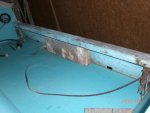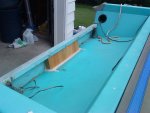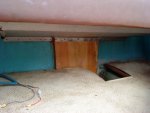Re: Changing transom wood
I'm wondering if you could put one in without disturbing the aluminum. Make the replacement out of two or three pieces....glued together and fiberglassed after they're put into place.
I messed around with that idea here on mine, its fine till you get to the last piece.
Maybe if you used 1/4" and could get the last piece to flex a bit it would work. You would also need a good way to clamp all the layers tight to maintain good strength when it was all done.
I also gave some thought to removing the top channel or cap, but once the new plywood is in place, you will not be able to re-rivet the area above the new wood panel. On top of that, it's nearly impossible to apply enough force with an inline rivet gun to properly crush the rivets which are located within the that top C channel. I suppose it could be put back with stainless carriage bolts though.
So far the only feasible method I see that don't entail cutting or damaging the original hull assembly is to pour in the transom panel using something like Nida Bond pourable transom material. If I did this, I think I'd bolt two C channel supports on both sides using the original transom bolt holes, then cover them with an aluminum panel. Then close in the top the same way, drilling a center pour hole in the top channel. It would take very little of the stuff, probably only a few gallons.
Another idea that crossed my mind after doing some work on an older aluminum bass boat which used only corrugated aluminum for it's transom core.
I was thinking of maybe just taking 1.5" OD thick wall square aluminum tubing and making the transom out of several vertical lengths, which would be easy to install, bolting the outer tubes to the original holes, and using metal epoxy to assemble the pieces. I know from my automotive experience that epoxy is more than capable of holding aluminum together in a structural application. The tubes could be put in place one at a time, they would be far stronger and more rigid than wood, they wouldn't require any cutting of the hull. I would pretty much coat each one with epoxy, as well as coat the final assembly. I could even fill the tubes with a pourable transom compound to prevent crushing when the bolts were tightened. (This would also allow using thinner tubing).
The screws attaching the splashwell to the transom panel, plus an added lower cross brace at deck level would tie them all together as well. This would no doubt make for a very long lasting solution, even the last tube would easily fit into place since the whole assembly could move about until the last tube was in place. I'd use a slow cure epoxy to give me plenty of working time and to allow getting them all in place and bolted up prior to the epoxy drying.
Since I'm leaning towards an all aluminum deck and supports, or possibly just aluminum under supports and a composite deck, it would make for a completely wood free boat and lessen the overall weight a good bit as well.



























